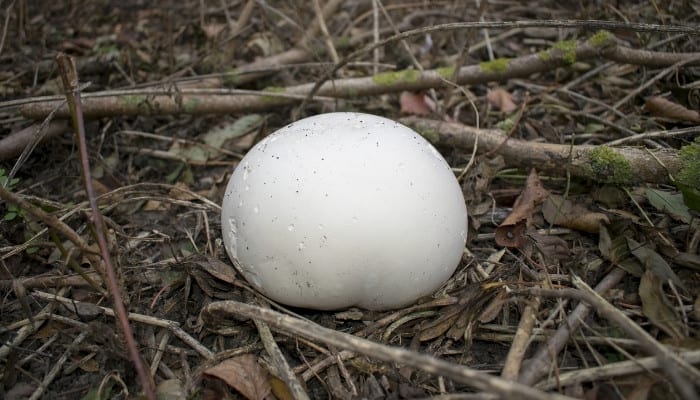Can puffball mushrooms be eaten? The majority of puffballs are safe to eat, and the mature ones can be consumed raw or cooked. However, some mushrooms that resemble young puffballs are highly toxic.
Remember the accurate identification of edible puffballs, particularly the giant puffball mushroom (Calvatia gigantea). From pigskin puffballs to identifying features like smoothness to the presence of gills, we’ll help you understand how to make sure you’re eating the right fungus. Wild mushrooms often are edible, but it’s important to pause and check.
Fun fact: Puffballs were traditionally used in Tibet for making ink, and it’s been used as a bee-smoking fuel for beekeepers.
Key Takeaways
- To tell if a puffball mushroom is edible, make sure it has no gills, pores, cap, stem, or spine, and then look for the ball-shaped meat to have a clean white color when opened up. (Source)
- Are puffball mushrooms poisonous to dogs? Puffball mushrooms and their look-alikes can be harmful to dogs, potentially more so due to their sensitive noses and airborne mushroom spores. (Source)
- Avoiding Poisonous Look-alikes: Be cautious of young Amanita and Scleroderma mushrooms, which can resemble puffballs but are toxic. Look for the absence of a stalk or veil in true puffballs.
- To prep and eat, try a simple fried puffball slice recipe: simply heat some butter in a pan, saute sliced puffball mushrooms for a few minutes, and season with salt and pepper. Expect to pay $20-$30/lb for high-quality, large foraged Puffball mushrooms.
How To Identify Edible Puffball Mushrooms (Giant Puffball Identification)
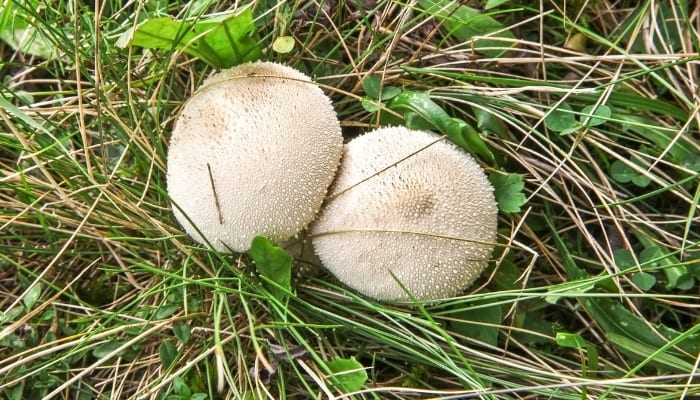
The first step to identifying edible puffball mushrooms is to make sure the mushroom has no gills, pores, cap, stem, or spine.
It should look like a ball or have a ball-type shape with a stem attached to the ground. Once you open it up, it should be a clean white color.
Puffball Mushroom Facts
Puffball mushrooms are named for the brown spores, like dust, that puff out when squeezed. They belong to the Basidiomycota division of mushrooms.
Real puffball mushrooms don’t have visible stalks or stems; they are round like a ball for the most part. They don’t have an open cap like many mushrooms do either; rather they produce spores internally.
The distinguishing feature of all puffballs is that they do not have an open cap with spore-bearing gills. Instead, spores are produced internally.
Are All Puffball Mushrooms Edible?
Not all puffball mushrooms are edible at every growth stage. Only puffball mushrooms that are entirely white on the inside should be eaten.
If the mushroom’s white color has any off-color hints or is gray or brown, it may be toxic and not edible.
Can You Eat Puffball Mushrooms Raw?
As long as the inside of the mushroom is white – pure white and only white – you can eat puffballs raw or cooked. If the puffball is large enough, you may even be able to eat it as a stand-alone meal. Have a look at our section below for more on how to cook and prepare puffball mushrooms, including recipes!
What Happens If You Inhale Puffball Spores?
If you inhale puffball spores, more than likely nothing is going to happen. That said, there is a respiratory disease (lycoperdonosis) that is induced by inhaling extreme amounts of mature puffball spores.
The disease is classified as inflammation within the lung of the alveoli, thanks to the dust causing hypersensitivity pneumonitis.
Common Types of Puffball Mushrooms
There are several types of common puffball mushrooms. Below, we list the most significant varieties:
- Bovista – The Bovista puffball mushroom is a genus that belongs to the group of fungi known as “true puffballs.”
- Calvatia – The Calvatia puffball mushroom is the genus that produces C. gigantea, the puffballs that grow as large as soccer balls.
- Handkea – The Handkea puffball mushroom is a genus that belongs to the Agaricaceae family. It has curvy slits on its body rather than typical pores.
- Lycoperdon – The Lycoperdon puffball mushroom is one of the most widespread. They are pear-shaped puffballs with approximately 50 species worldwide.
- Scleroderma – The Scleroderma is a fungi genus that is found all over the world and is commonly known as “earth balls.” They belong to the Boletales Sclerodermatineae order of puffballs.
You should be absolutely positive of a mushroom’s identity before consuming. Be familiar with toxic varieties found in your area, and check out these 24 Toxic Mushrooms To Avoid to educate yourself.
Puffball Look-Alikes, How To Identify + Avoid
If you choose to pick your own puffball mushrooms, be wary. Numerous poisonous mushrooms look like puffballs that you really don’t want any part of. The worst part is that they are extremely easy to mistake for the real thing.
Here are the most common Puffball mushroom look-alikes, and below this list we’ll present pictures along with a little more discussion:
- Amanita: Includes hundreds of mushrooms, mostly poisonous, toxic, or psychedelic. White in color, resembling puffballs, especially when young. Fatal and identifiable by their veil and stalk. (Source)
- Sclerodomera: Poisonous and commonly mistaken for puffball mushrooms. Young Sclerodomera have hard white flesh, unlike the soft and spongy texture of puffballs. Responsible for several deaths. (Source)
- Destroying Angel (Amanita bisporigera): Found in Europe and North America, this type resembles a puffball when young and is white inside. Responsible for about 90% of poisonous mushroom fatalities in these areas. (Source)
- Death Cap (Amanita phalloides): Also known as death cup, it’s a deadly Amanita species mistaken for small puffballs when young. White inside like healthy puffballs. (Source)
Amanita
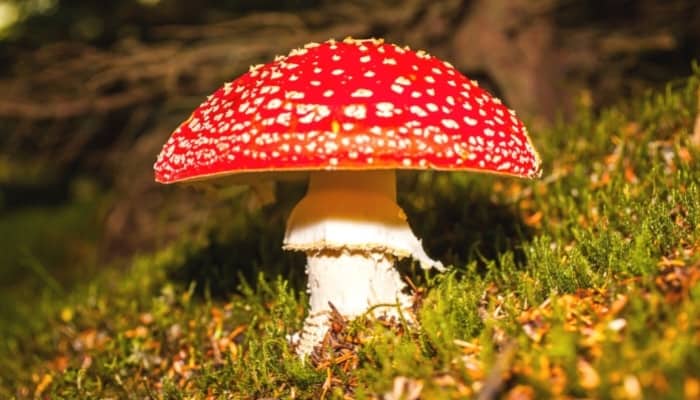
The Amanita genus of mushrooms includes hundreds of mushrooms. Most of the amanitas in the world are poisonous, toxic, or even psychedelic (at the chance of death).
That said, many amanitas are white and just so happen to resemble puffballs (especially when they are young).
Amanitas are fatal and should never be eaten. They can be identified by their veil and their stalk, both of which puffball mushrooms do not have.
Sclerodomera
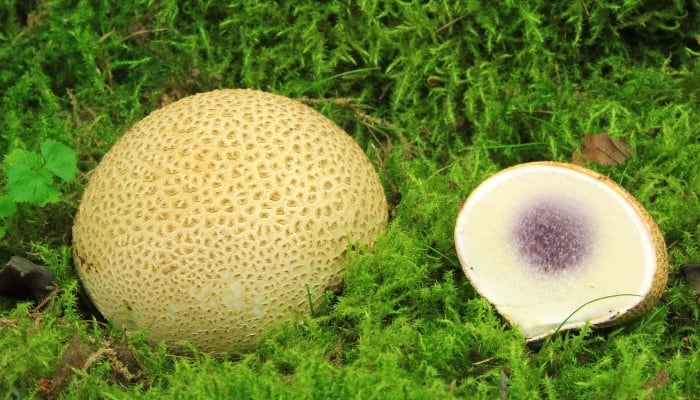
The Sclerodomera mushroom is another poisonous mushroom that is commonly mistaken for puffball mushrooms.
Again, it is especially when they are young mushrooms that they appear so similar to true puffball mushrooms.
The one difference is that inside a young Sclerodomera, the white flesh is hard, not soft and spongy like in a puffball. Scleroderma has been responsible for several deaths.
Destroying Angel (Amanita bisporigera)
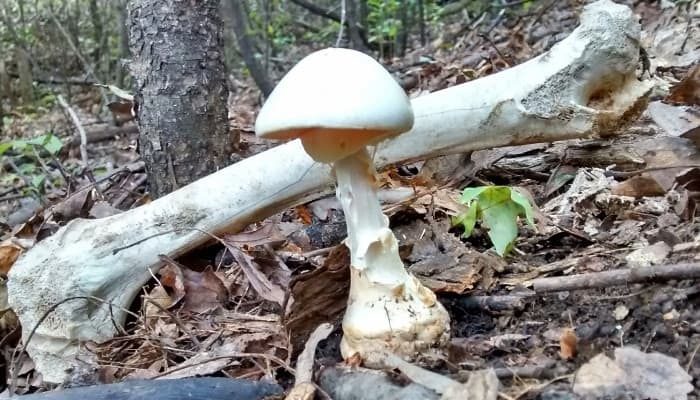
The destroying angel, scientifically known as the Amanita bisporigera, is a type of Amanita that can be found in Europe and North America.
It is responsible for approximately 90% of poisonous mushroom fatalities in those areas. When it is young, it looks very much like a puffball and is even white inside.
This mushroom will kill you if you eat it.
Death Cap (Amanita phalloides)
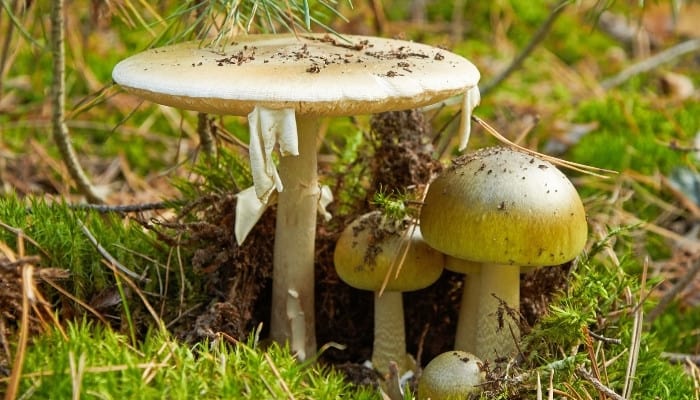
The death cap, scientifically known as the Amantia phalloides and also sometimes called death cup, is another deadly Amanita species that is easily mistaken for small puffballs when they are young mushrooms.
They are also white inside, like healthy puffballs.
How To Cook Puffball Mushrooms
Puffball mushrooms are super easy to work with in the kitchen, and they’re very nutritious as well, especially if you forage your own mushrooms (more on that below the recipes).
Have a look at the video above for some inspiration, and reference the crispy puffball parmesan bites recipe below for a similar recipe using breading to add a nice crunch.
Simple & Delightful Puffball Mushroom Recipes:
Gourmet Classic Fried Puffballs: There’s nothing quite like the simplicity and elegance of classic fried puffballs. This recipe brings out the natural, earthy flavors of the mushrooms, enhanced by the rich, buttery goodness. Perfect as a side dish or a savory snack, these golden-brown delights are a testament to the beauty of simplicity in cooking.
- Wash and slice the puffballs about a quarter inch thick.
- Melt a generous knob of butter (~1TBSP or a little more) in a skillet over medium heat.
- Gently fry the slices, turning them once, until they’re a delectable golden brown, usually taking about 4-5 minutes. Season with salt and pepper as soon as they’re in the pan, and flip about halfway through.
Crispy Puffball Parmesan Bites: Get ready to be wowed by these Puffball Parmesan Bites – a true crowd-pleaser! These bites pack a punch of flavor with their cheesy, crispy coating. They’re the perfect fusion of texture and taste, making them an irresistible appetizer or a fun, snackable treat for any gathering.
- Start by cutting the puffballs into small, bite-sized pieces.
- Dip each piece into a beaten egg, then lovingly coat them in a mixture of grated Parmesan cheese and breadcrumbs.
- Fry them in a skillet until they achieve a crispy, golden exterior.
For more tasty mushroom recipes scroll through our page and other inspiring articles.
Where Can You Forage for Puffball Mushrooms?
Foraging for puffball mushrooms can be an exciting outdoor activity, especially if you know where and when to look. These distinctive fungi are typically found in meadows, fields, and forest edges.
The best time to forage for them is during the late summer to fall. It’s crucial to ensure that the puffballs you find are pure white inside, as any discoloration is a sign that they’re not fit for consumption.
How Much Do Puffball Mushrooms Cost?
The cost of Puffball mushrooms can vary depending on the region and their availability. Generally, puffball mushrooms can be a more budget-friendly option compared to other gourmet mushrooms, especially when they are in season.
Their affordability makes them an excellent choice for those looking to experiment with different mushroom varieties without breaking the bank. Keep an eye on local markets or specialty stores for the best deals during their growing season. for high-quality foraged mushrooms, expect to pay up to $30/lb.
Related Questions:
Are Puffball Mushrooms Poisonous to Dogs?
As we mentioned in the key takeaways, puffball mushrooms, and the look-alikes, are just as harmful to dogs as they are to humans. In fact, they are more dangerous to dogs because dog noses are so much more powerful (and sensitive).
That means they are more likely to develop lycoperdonosis than you are.
To learn more about what mushrooms can be dangerous for you and your pet, check our article on False Parasol.
How Do I Get Rid of Puffballs in My Yard?
The best way to get rid of puffball mushrooms from your yard is to put on your pants, grab your shovel, roll up your sleeves, and go dig them up.
After you’ve removed them, fertilize the area or plant it with fresh sod so the new turf discourages further fungi development.
You may also want to remove roots and other organic debris from your yard that may promote mushroom growth as well.

